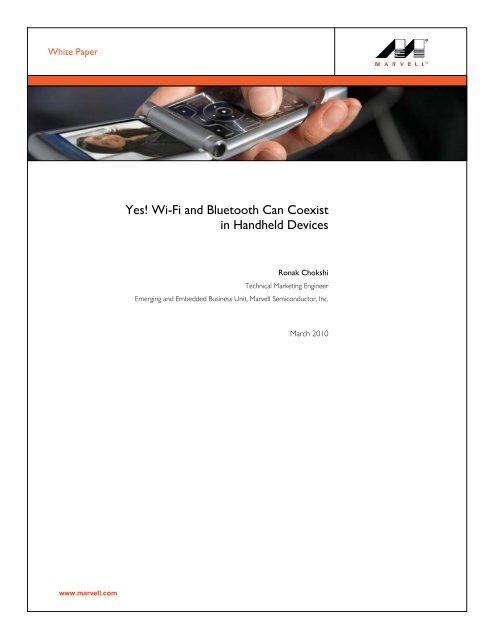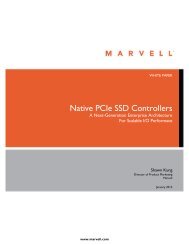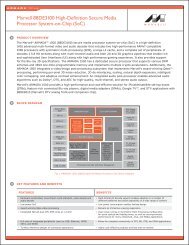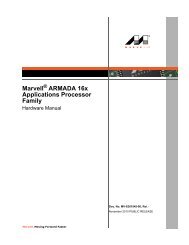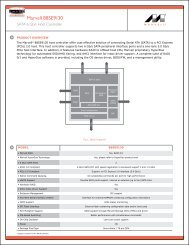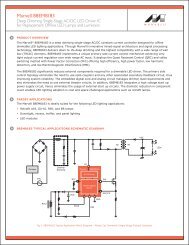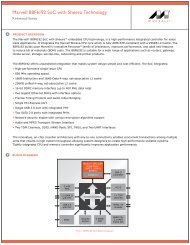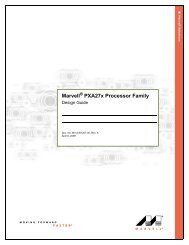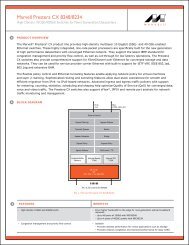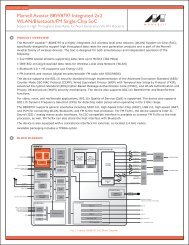Yes! Wi-Fi and Bluetooth Can Coexist in Handheld Devices
Yes! Wi-Fi and Bluetooth Can Coexist in Handheld Devices - Marvell
Yes! Wi-Fi and Bluetooth Can Coexist in Handheld Devices - Marvell
You also want an ePaper? Increase the reach of your titles
YUMPU automatically turns print PDFs into web optimized ePapers that Google loves.
White Paper<br />
<strong>Yes</strong>! <strong>Wi</strong>-<strong>Fi</strong> <strong>and</strong> <strong>Bluetooth</strong> <strong>Can</strong> <strong>Coexist</strong><br />
<strong>in</strong> H<strong>and</strong>held <strong>Devices</strong><br />
Ronak Chokshi<br />
Technical Market<strong>in</strong>g Eng<strong>in</strong>eer<br />
Emerg<strong>in</strong>g <strong>and</strong> Embedded Bus<strong>in</strong>ess Unit, Marvell Semiconductor, Inc.<br />
March 2010<br />
www.marvell.com
Introduction<br />
Imag<strong>in</strong>e a room full of people talk<strong>in</strong>g. There may be a lot of noise, but as long as people are spread out <strong>and</strong> not convers<strong>in</strong>g too loud,<br />
two people <strong>in</strong> close proximity can successfully carry on a conversation. However, if someone nearby started shout<strong>in</strong>g, it would be<br />
very difficult to cont<strong>in</strong>ue that discussion.<br />
Similarly, when <strong>Wi</strong>-<strong>Fi</strong> <strong>and</strong> <strong>Bluetooth</strong> ® are put <strong>in</strong>to the same device—particularly a smaller h<strong>and</strong>held type—the signals transmitted can<br />
cause <strong>in</strong>terference with each other, thereby disrupt<strong>in</strong>g the “conversation.”<br />
As these two wireless technologies cont<strong>in</strong>ue to permeate the consumer electronics market, people cont<strong>in</strong>ue to ask “<strong>Can</strong> these <strong>Wi</strong>-<strong>Fi</strong><br />
<strong>and</strong> <strong>Bluetooth</strong> coexist <strong>in</strong> a s<strong>in</strong>gle device?” The answer is yes.<br />
This white paper discusses the emergence of <strong>Wi</strong>-<strong>Fi</strong> <strong>and</strong> <strong>Bluetooth</strong> technologies on a s<strong>in</strong>gle <strong>in</strong>tegrated circuit (IC) for use <strong>in</strong> today’s<br />
popular h<strong>and</strong>held devices. It expla<strong>in</strong>s the potential challenges of compet<strong>in</strong>g wireless signals, as well as <strong>in</strong>novative design techniques<br />
to help orig<strong>in</strong>al equipment manufacturers (OEMs) overcome potential issues <strong>and</strong> rapidly develop cost-effective consumer devices.<br />
<strong>Fi</strong>nally, it exp<strong>and</strong>s on the advantages that Marvell’s Avastar ® family of multi-functional radios (MFRs) have over compet<strong>in</strong>g devices<br />
available <strong>in</strong> the market today.<br />
The Increas<strong>in</strong>g Popularity of <strong>Wi</strong>-<strong>Fi</strong> <strong>and</strong> <strong>Bluetooth</strong>--Together<br />
<strong>Wi</strong>-<strong>Fi</strong> <strong>and</strong> <strong>Bluetooth</strong> are two of the most widely used wireless technologies <strong>in</strong> consumer electronic devices. Although devices <strong>in</strong>clud<strong>in</strong>g<br />
these two technologies can use separate ICs on an embedded platform, with the latest advances <strong>in</strong> technology <strong>in</strong>novation, it is<br />
possible to co-locate <strong>Wi</strong>-<strong>Fi</strong> <strong>and</strong> <strong>Bluetooth</strong> devices on one IC, thereby reduc<strong>in</strong>g cost, size <strong>and</strong> time-to-market.<br />
These technologies operate <strong>in</strong> the 2.4GHz Industrial, Scientific <strong>and</strong> Medical Device b<strong>and</strong> (ISM) b<strong>and</strong>, but are disparate from each<br />
other <strong>in</strong> almost every manner. <strong>Wi</strong>-<strong>Fi</strong> devices operate on an asynchronous protocol <strong>and</strong> access the wireless medium us<strong>in</strong>g the Carrier<br />
Sense Multiple Access / Collision Avoidance (CSMA/CA) mechanism. <strong>Wi</strong>th <strong>Bluetooth</strong> devices, the medium access time is slotted. Also,<br />
the advent of 802.11n technology <strong>in</strong> h<strong>and</strong>held platforms poses the difficult challenge to accommodate the requirements of both <strong>Wi</strong>-<strong>Fi</strong><br />
<strong>and</strong> <strong>Bluetooth</strong> l<strong>in</strong>ks while ensur<strong>in</strong>g optimal performance.<br />
While it's generally acknowledged that <strong>Bluetooth</strong> <strong>and</strong> <strong>Wi</strong>-<strong>Fi</strong> can coexist <strong>in</strong> harmony, it's another matter to get them to work together<br />
while resid<strong>in</strong>g <strong>in</strong> the same device. Interference problems from collisions—s<strong>in</strong>ce both use the same radio frequency (RF) b<strong>and</strong>—causes<br />
dropped packets, which only cascades <strong>in</strong>to other problems.<br />
Despite this ambient RF <strong>in</strong>terference, <strong>Bluetooth</strong> <strong>and</strong> <strong>Wi</strong>-<strong>Fi</strong> have ga<strong>in</strong>ed <strong>in</strong>creas<strong>in</strong>g popularity with consumers <strong>in</strong> recent years, driven<br />
by the array of h<strong>and</strong>held devices available today. As both technologies are placed <strong>in</strong> close physical proximity, coexistence is a<br />
priority.<br />
Below we outl<strong>in</strong>e the challenges of <strong>Wi</strong>-<strong>Fi</strong> <strong>and</strong> <strong>Bluetooth</strong> co-existence <strong>in</strong> small form-factor products, <strong>and</strong> then discuss detailed<br />
measures that can be implemented by OEM designers to counteract any <strong>in</strong>terference.<br />
<strong>Coexist</strong>ence <strong>in</strong> H<strong>and</strong>held <strong>Devices</strong><br />
More <strong>and</strong> more h<strong>and</strong>held devices, from personal digital assistants (PDAs) to smartphones, are be<strong>in</strong>g shipped with both <strong>Wi</strong>-<strong>Fi</strong> <strong>and</strong><br />
<strong>Bluetooth</strong> technologies. <strong>Wi</strong>th widespread use of these “dual-mode” devices, co-existence has become a complex challenge.<br />
<strong>Fi</strong>gure 1 illustrates the most common cases for simultaneous usage of <strong>Wi</strong>-<strong>Fi</strong> <strong>and</strong> <strong>Bluetooth</strong> technologies.<br />
Page 2 <strong>Yes</strong>! <strong>Wi</strong>-<strong>Fi</strong> <strong>and</strong> <strong>Bluetooth</strong> <strong>Can</strong> <strong>Coexist</strong> <strong>in</strong> H<strong>and</strong>held <strong>Devices</strong> March 2010
<strong>Fi</strong>gure 1: Typical <strong>Wi</strong>-<strong>Fi</strong> <strong>and</strong> <strong>Bluetooth</strong> use cases for smartphones.<br />
Data<br />
Video<br />
Internet<br />
Stream<strong>in</strong>g<br />
music<br />
UMA/IMS<br />
VoIP<br />
Cellular<br />
network<br />
802.11bgn<br />
MMH<br />
<strong>Wi</strong>-<strong>Fi</strong> BSS<br />
A2DP<br />
802.11bgn<br />
HFP<br />
DUN/OPP<br />
BPP<br />
The smartphone depicted at the center of the diagram is connected via <strong>Wi</strong>-<strong>Fi</strong> to an access po<strong>in</strong>t <strong>and</strong> via the cellular network. <strong>Wi</strong>th<br />
built-<strong>in</strong> <strong>Bluetooth</strong>, the smartphone can also be used with a host of profiles such as H<strong>and</strong>s-Free Profile (HFP), Advanced Audio<br />
Distribution Profile (A2DP) for stream<strong>in</strong>g stereo music, Basic Pr<strong>in</strong>t<strong>in</strong>g Profile (BPP), Dial-Up Network<strong>in</strong>g (DUN), Object Push Profile<br />
(OPP) <strong>and</strong> so on.<br />
Today’s smartphones are also beg<strong>in</strong>n<strong>in</strong>g to serve as embedded access po<strong>in</strong>ts, whereby the phone creates a small <strong>Wi</strong>-<strong>Fi</strong> network that<br />
can h<strong>and</strong>le a limited number of clients. (See White Paper - Marvell Mobile Hotspot technology.)<br />
Depend<strong>in</strong>g on the <strong>in</strong>tended use cases, <strong>Wi</strong>-<strong>Fi</strong> <strong>and</strong> <strong>Bluetooth</strong> devices can take up the medium time for an extended period—for<br />
example, a <strong>Wi</strong>-<strong>Fi</strong> client actively scann<strong>in</strong>g or a <strong>Bluetooth</strong> device seek<strong>in</strong>g a peer us<strong>in</strong>g page or <strong>in</strong>quiry mechanisms. In any such<br />
operation, the other co-located device suffers from acute starvation <strong>in</strong> access<strong>in</strong>g wireless medium, result<strong>in</strong>g <strong>in</strong> delays <strong>in</strong> gett<strong>in</strong>g its<br />
own data packet(s) through the airwave.<br />
For OEMs seek<strong>in</strong>g to develop new h<strong>and</strong>held devices that <strong>in</strong>corporate both <strong>Wi</strong>-<strong>Fi</strong> <strong>and</strong> <strong>Bluetooth</strong> on a s<strong>in</strong>gle IC, there is a dist<strong>in</strong>ct<br />
requirement to optimize coexistence algorithms that enhance the performance of both technologies.<br />
High Level Design Strategies for Optimal Performance<br />
As both technologies have evolved, new techniques have been developed to enable <strong>Wi</strong>-<strong>Fi</strong> <strong>and</strong> <strong>Bluetooth</strong> to coexist easily with each<br />
other <strong>and</strong> other potential sources of <strong>in</strong>terference.<br />
As described below, designers can approach the coexistence challenge from both a “time doma<strong>in</strong>” <strong>and</strong> “frequency doma<strong>in</strong>” aspect:<br />
Time Doma<strong>in</strong><br />
In most consumer devices, due to size <strong>and</strong> cost constra<strong>in</strong>ts, manufacturers tend to design systems that share a s<strong>in</strong>gle antenna for<br />
both <strong>Wi</strong>-<strong>Fi</strong> <strong>and</strong> <strong>Bluetooth</strong> devices. As a result, <strong>Wi</strong>-<strong>Fi</strong> <strong>and</strong> <strong>Bluetooth</strong> transceivers have limited wireless access time to avoid packet<br />
collisions. Designers can address this issue by <strong>in</strong>corporat<strong>in</strong>g the follow<strong>in</strong>g mechanisms:<br />
March 2010 <strong>Yes</strong>! <strong>Wi</strong>-<strong>Fi</strong> <strong>and</strong> <strong>Bluetooth</strong> <strong>Can</strong> <strong>Coexist</strong> <strong>in</strong> H<strong>and</strong>held <strong>Devices</strong> Page 3
• Packet Traffic Arbiter (PTA). PTA is a dedicated hardware System-on-Chip (SoC) block that controls access of <strong>Wi</strong>-<strong>Fi</strong> <strong>and</strong><br />
<strong>Bluetooth</strong> devices to the antenna. It does this through pre-programmed priority of packet transmissions <strong>and</strong> receptions. In a<br />
discrete solution (i.e., separate <strong>Wi</strong>-<strong>Fi</strong> <strong>and</strong> <strong>Bluetooth</strong> SoCs), a unique set of protocols (e.g., 2-wire, 3-wire, 4-wire) is followed<br />
between the SoCs through hardware signal<strong>in</strong>g.<br />
In an <strong>in</strong>tegrated <strong>Wi</strong>-<strong>Fi</strong> <strong>and</strong> <strong>Bluetooth</strong> SoC, however, there can be additional “h<strong>and</strong>shakes” designed <strong>in</strong>to this block. Marvell <strong>Wi</strong>-<br />
<strong>Fi</strong>/<strong>Bluetooth</strong> multi-function radio MFR devices, for example, are designed to optimize medium access time for maximum yield of<br />
<strong>Wi</strong>-<strong>Fi</strong> throughput <strong>and</strong> <strong>Bluetooth</strong> audio quality through packet arbitration. (See <strong>Fi</strong>gure 2 below.)<br />
<strong>Fi</strong>gure 2: Example: <strong>Wi</strong>re <strong>in</strong>terface is a <strong>Wi</strong>-<strong>Fi</strong>/<strong>Bluetooth</strong> MFR solution.<br />
WLAN<br />
WLAN 2.4G Tx/Rx<br />
Intra-chip<br />
h<strong>and</strong>shake<br />
Front end<br />
module<br />
(FEM)<br />
BT<br />
MFR SoC<br />
BT Tx/Rx<br />
Control signals<br />
• PS-Poll <strong>and</strong> WMM Trigger Frames. One of the primary challenges with <strong>Wi</strong>-<strong>Fi</strong> <strong>and</strong> <strong>Bluetooth</strong> coexistence is controll<strong>in</strong>g downl<strong>in</strong>k<br />
traffic from the access po<strong>in</strong>t. Access po<strong>in</strong>ts are usually unaware of ongo<strong>in</strong>g <strong>Bluetooth</strong> traffic on the client <strong>Wi</strong>-<strong>Fi</strong> device. Downl<strong>in</strong>k<br />
frames from an access po<strong>in</strong>t can arrive anytime, creat<strong>in</strong>g over-the-air collisions. This results either <strong>in</strong> very low <strong>Wi</strong>-<strong>Fi</strong> throughput<br />
or eventually lead<strong>in</strong>g to <strong>Wi</strong>-<strong>Fi</strong> l<strong>in</strong>k loss, depend<strong>in</strong>g on the type of access po<strong>in</strong>t. Therefore, it is important to control the downl<strong>in</strong>k<br />
traffic from the access po<strong>in</strong>t.<br />
This can be accomplished either by us<strong>in</strong>g PowerSave-Poll (PS-Poll) frames or <strong>Wi</strong>-<strong>Fi</strong> MultiMedia (WMM) Trigger frames. (See<br />
<strong>Fi</strong>gure 3) The former polls the access po<strong>in</strong>t one data packet at a time, whereas the latter can be used to download multiple<br />
frames at a time, although <strong>in</strong> different modes of operation. The former is used <strong>in</strong> IEEE Power Save mode, whereas the latter is<br />
used when the <strong>Wi</strong>-<strong>Fi</strong> device operates <strong>in</strong> WMM Power Save mode. These enhancements are particularly helpful when the client<br />
<strong>Wi</strong>-<strong>Fi</strong> device associates with an aggressively rate-dropp<strong>in</strong>g access po<strong>in</strong>t.<br />
In an <strong>in</strong>tegrated <strong>Wi</strong>-<strong>Fi</strong>/ <strong>Bluetooth</strong> SoC, it is possible to l<strong>in</strong>e up these frames with the <strong>Bluetooth</strong> frames, as shown <strong>in</strong> the figure<br />
below, so that the audio quality does not suffer <strong>and</strong> the downl<strong>in</strong>k <strong>Wi</strong>-<strong>Fi</strong> traffic is also susta<strong>in</strong>ed—thereby m<strong>in</strong>imiz<strong>in</strong>g over-the-air<br />
collisions. This is quite challeng<strong>in</strong>g when a discrete set of <strong>Wi</strong>-<strong>Fi</strong> <strong>and</strong> <strong>Bluetooth</strong> SoCs are used.<br />
Page 4 <strong>Yes</strong>! <strong>Wi</strong>-<strong>Fi</strong> <strong>and</strong> <strong>Bluetooth</strong> <strong>Can</strong> <strong>Coexist</strong> <strong>in</strong> H<strong>and</strong>held <strong>Devices</strong> March 2010
<strong>Fi</strong>gure 3: PS-Poll <strong>and</strong> WMM Trigger frames.<br />
ACK<br />
Data pkt<br />
ACK<br />
Trigger/data<br />
pkts<br />
ACK<br />
Data pkt<br />
ACK<br />
PS-Poll<br />
BT<br />
BT<br />
BT<br />
BT<br />
Frequency Doma<strong>in</strong><br />
S<strong>in</strong>ce <strong>Wi</strong>-<strong>Fi</strong> <strong>and</strong> <strong>Bluetooth</strong> share the 2.4GHz ISM frequency b<strong>and</strong>, each of these two technologies need to be partitioned to use a<br />
specific set of frequencies, thus provid<strong>in</strong>g enough RF isolation. This can be accomplished through the follow<strong>in</strong>g design techniques:<br />
• Adaptive Frequency Hopp<strong>in</strong>g (AFH). Start<strong>in</strong>g from version 1.2 of the <strong>Bluetooth</strong> specification, all <strong>Bluetooth</strong> devices offered<br />
Adaptive Frequency-hopp<strong>in</strong>g (AFH) spread spectrum as a key enhancement. This enables the <strong>Bluetooth</strong> device to use only a<br />
certa<strong>in</strong> (programmable) set of frequencies as part of its hopp<strong>in</strong>g sequence.From a <strong>Wi</strong>-<strong>Fi</strong> <strong>and</strong> <strong>Bluetooth</strong> coexistence perspective,<br />
this feature is very helpful. Based on the <strong>Wi</strong>-<strong>Fi</strong> channel, the <strong>Bluetooth</strong> device can be programmed to not use the frequencies<br />
around the <strong>Wi</strong>-<strong>Fi</strong> channel’s center frequency. Hence, the <strong>Bluetooth</strong> device is programmed with a static (or adoptive) mask of<br />
channels that should not be <strong>in</strong>cluded <strong>in</strong> the hopp<strong>in</strong>g pattern.<br />
The specifics of how many channels are required to be blocked should be governed by: 1) RF front-end components <strong>and</strong><br />
isolation thereof, 2) transmit power level of the <strong>Wi</strong>-<strong>Fi</strong> <strong>and</strong> <strong>Bluetooth</strong> devices, 3) flexibility of allow<strong>in</strong>g simultaneous transmit <strong>and</strong><br />
receive activities on <strong>Wi</strong>-<strong>Fi</strong> <strong>and</strong> <strong>Bluetooth</strong> devices <strong>and</strong> 4) maximum adjacent channel rejection (ACR) of the <strong>Wi</strong>-<strong>Fi</strong> <strong>and</strong> <strong>Bluetooth</strong><br />
devices.<br />
<strong>Fi</strong>gure 4 below depicts the channel map allocated for <strong>Wi</strong>-<strong>Fi</strong> <strong>and</strong> <strong>Bluetooth</strong> devices. There are a total of 13 <strong>Wi</strong>-<strong>Fi</strong> <strong>and</strong> 79 <strong>Bluetooth</strong><br />
channels <strong>in</strong> this b<strong>and</strong>. <strong>Wi</strong>-<strong>Fi</strong> channels have a center frequency <strong>and</strong> are approximately 23 MHz wide, while <strong>Bluetooth</strong> channels are<br />
only 1 MHz wide.<br />
<strong>Fi</strong>gure 4: <strong>Wi</strong>-<strong>Fi</strong> <strong>and</strong> <strong>Bluetooth</strong> channel allocation.<br />
Cent er Freq<br />
00 01 02 03 04 05 06 07 08 09 10 11 12 13 14 15 16 17 18 19 20 21 22 23 24 25 26 27 28 29 30 31 32 33 34 35 36 37 38 39 40 41<br />
(2.4xx GHz)<br />
BT Channel Guard 0 1 2 3 4 5 6 7 8 9 10 11 12 13 14 15 16 17 18 19 20 21 22 23 24 25 26 27 28 29 30 31 32 33 34 35 36 37 38 39<br />
WLAN Channel<br />
(center freq <strong>in</strong><br />
GHz)<br />
1 (2.412) 6 (2.437)<br />
2 (2.417) 7 (2.442)<br />
3 (2.422) 8 (2.447)<br />
4 (2.427) 9 (2.452)<br />
5 (2.432)<br />
Center Freq<br />
(2.4xx GHz)<br />
42 43 44 45 46 47 48 49 50 51 52 53 54 55 56 57 58 59 60 61 62 63 64 65 66 67 68 69 70 71 72 73 74 75 76 77 78 79 80 81 82 83<br />
BT Channel 40 41 42 43 44 45 46 47 48 49 50 51 52 53 54 55 56 57 58 59 60 61 62 63 64 65 66 67 68 69 70 71 72 73 74 75 76 77 78 Guard<br />
WLAN Channel<br />
(center freq <strong>in</strong><br />
GHz)<br />
6 (2.437) 11 (2.462)<br />
7 (2.442) 12 (2.467)<br />
8 (2.447) 13 (2.472)<br />
9 (2.452)<br />
5 (2.432) 10 (2.457)<br />
March 2010 <strong>Yes</strong>! <strong>Wi</strong>-<strong>Fi</strong> <strong>and</strong> <strong>Bluetooth</strong> <strong>Can</strong> <strong>Coexist</strong> <strong>in</strong> H<strong>and</strong>held <strong>Devices</strong> Page 5
• RF Isolation <strong>and</strong> Ga<strong>in</strong> Adjustment. Most <strong>Wi</strong>-<strong>Fi</strong> <strong>and</strong> <strong>Bluetooth</strong> implementations offer transmit power control algorithms<br />
where, accord<strong>in</strong>g to the l<strong>in</strong>k conditions, the transmitt<strong>in</strong>g device either <strong>in</strong>creases or decreases transmit power. The higher the<br />
transmit power from the <strong>Wi</strong>-<strong>Fi</strong> device, the more <strong>Bluetooth</strong> channels one needs to mask <strong>in</strong> order to ensure low packet error rate<br />
(PER).<br />
It is also observed that, if the RF isolation between the <strong>Wi</strong>-<strong>Fi</strong> <strong>and</strong> <strong>Bluetooth</strong> devices is not enough, transmissions from either of<br />
the two devices can saturate the receive path of the other device, assum<strong>in</strong>g the transmit power to be considerably high. (See<br />
<strong>Fi</strong>gure 5 below.) This could result <strong>in</strong> a l<strong>in</strong>k disconnect or high PER <strong>and</strong>, therefore, detract from the overall user experience.<br />
There are two ways to resolve this problem: 1) adjust the maximum ga<strong>in</strong> of the <strong>in</strong>termediate receiver stages of the <strong>in</strong>dividual<br />
<strong>Wi</strong>-<strong>Fi</strong> <strong>and</strong> <strong>Bluetooth</strong> devices or 2) adjust the transmit power of the two devices so that it is low enough to sufficiently ma<strong>in</strong>ta<strong>in</strong><br />
the <strong>in</strong>dividual l<strong>in</strong>ks. These are particularly important <strong>in</strong> a design that uses shared antenna between <strong>Wi</strong>-<strong>Fi</strong> <strong>and</strong> <strong>Bluetooth</strong>.<br />
<strong>Fi</strong>gure 5: Examples of RF Isolation.<br />
Example Module<br />
WLAN Tx:<br />
13-15 dBm<br />
Interference: <strong>Bluetooth</strong> on<br />
+15 dBm<br />
-20 dBm<br />
WLAN<br />
Other Parts<br />
Close<br />
Antenna<br />
Isolation<br />
20-40 dBm<br />
e.g. 20 dB<br />
isolation<br />
Interference: WLAN on<br />
0 dBm<br />
-5 dBm 0 dBm<br />
<strong>Bluetooth</strong><br />
<strong>Bluetooth</strong> Tx:<br />
0-10 dBm<br />
+15 dBm<br />
e.g. 20 dB<br />
isolation<br />
Solutions Cater<strong>in</strong>g to Offer Best-<strong>in</strong>-Class Overall User Experience<br />
As Marvell has <strong>in</strong>tegrated the <strong>Wi</strong>-<strong>Fi</strong> <strong>and</strong> <strong>Bluetooth</strong> devices on a s<strong>in</strong>gle silicon die, the Marvell’s Avastar family of wireless connectivity<br />
solutions has mastered the coexistence technologies to offer world-class performance, lead<strong>in</strong>g to an overall user experience that<br />
simultaneously delivers maximum <strong>Wi</strong>-<strong>Fi</strong> throughput with optimal <strong>Bluetooth</strong> voice quality.<br />
Among these coexistence technologies are:<br />
• Alignment of PS-Poll / Trigger frames with SCO / eSCO slots to optimize Rx traffic, as mentioned <strong>in</strong> the section above<br />
• Usage of larger <strong>Wi</strong>-<strong>Fi</strong> time w<strong>in</strong>dow whenever available, especially dur<strong>in</strong>g eSCO<br />
• Dynamic <strong>Bluetooth</strong>-aware <strong>Wi</strong>-<strong>Fi</strong> rate adaptation scheme<br />
• Interception of <strong>Bluetooth</strong> page/<strong>in</strong>quiry to yield for WLAN traffic<br />
• Partition airtime between <strong>Bluetooth</strong> <strong>and</strong> <strong>Wi</strong>-<strong>Fi</strong> traffic to yield best performance possible<br />
• <strong>Coexist</strong>ence for a multi-profile usage scenarios, for example, runn<strong>in</strong>g HFP (i.e., SCO/eSCO) <strong>and</strong> Personal Area Network (PAN)-<br />
over-Asynchronous Connectionless L<strong>in</strong>k (ACL) simultaneously with <strong>Wi</strong>-<strong>Fi</strong> traffic<br />
• Scheme to susta<strong>in</strong> the overall network throughput <strong>in</strong> a multiple-client scenario (e.g., multiple <strong>Wi</strong><strong>Fi</strong>+<strong>Bluetooth</strong> enabled<br />
smartphones <strong>in</strong> a small conference room connected to the same access po<strong>in</strong>t <strong>and</strong> paired with their <strong>in</strong>dividual headsets)<br />
• <strong>Wi</strong>-<strong>Fi</strong> <strong>and</strong> <strong>Bluetooth</strong> l<strong>in</strong>k-aware performance<br />
Page 6 <strong>Yes</strong>! <strong>Wi</strong>-<strong>Fi</strong> <strong>and</strong> <strong>Bluetooth</strong> <strong>Can</strong> <strong>Coexist</strong> <strong>in</strong> H<strong>and</strong>held <strong>Devices</strong> March 2010
• BT-aware 802.11n block acknowledgement streams<br />
• Optimal number of aggregates versus Modulation <strong>and</strong> Cod<strong>in</strong>g Scheme (MCS) rate <strong>in</strong>dex <strong>in</strong> the transmit direction<br />
<strong>Fi</strong>gure 6: Marvell Smart Radio <strong>Coexist</strong>ence<br />
Proven RF Front End Design<br />
Efficient Silicon Arbitration<br />
Intelligent Co-ex Manager <strong>in</strong> FW<br />
Best <strong>in</strong> Class Radio Management<br />
for Simultaneous Use Cases<br />
Marvell’s Avastar family of MFR combo devices ensures:<br />
• A Mean Op<strong>in</strong>ion Score (MOS) of more than 4.0 for voice quality over the <strong>Bluetooth</strong> l<strong>in</strong>k at all times, with or without the<br />
<strong>Wi</strong>-<strong>Fi</strong> l<strong>in</strong>k be<strong>in</strong>g active<br />
• M<strong>in</strong>imal impact <strong>in</strong> an on-go<strong>in</strong>g A2DP stream at all times, with or without the <strong>Wi</strong>-<strong>Fi</strong> l<strong>in</strong>k be<strong>in</strong>g active<br />
• No <strong>Wi</strong>-<strong>Fi</strong> l<strong>in</strong>k loss between the client <strong>and</strong> access po<strong>in</strong>t, with or without the <strong>Bluetooth</strong> l<strong>in</strong>k be<strong>in</strong>g active<br />
• Theoretical maximum <strong>Wi</strong>-<strong>Fi</strong> 802.11a/b/g/n throughput achievable while coexist<strong>in</strong>g with collocated <strong>Bluetooth</strong> l<strong>in</strong>ks.<br />
Conclusion<br />
The market for <strong>Wi</strong>-<strong>Fi</strong> <strong>and</strong> <strong>Bluetooth</strong> devices is grow<strong>in</strong>g rapidly, driv<strong>in</strong>g <strong>in</strong>creased dem<strong>and</strong> for <strong>in</strong>tegration <strong>and</strong> coexistence among<br />
these two technologies. Through its <strong>in</strong>novative design techniques <strong>and</strong> solutions, as part of its low power MFR devices, Marvell has<br />
found a way to limit <strong>in</strong>terference between <strong>Wi</strong>-<strong>Fi</strong> <strong>and</strong> <strong>Bluetooth</strong> technologies <strong>in</strong> h<strong>and</strong>held devices. The techniques <strong>and</strong> technologies<br />
described above can help OEMs address the design constra<strong>in</strong>ts of <strong>Wi</strong>-<strong>Fi</strong> <strong>and</strong> <strong>Bluetooth</strong> devices <strong>and</strong> develop comb<strong>in</strong>ed <strong>Wi</strong>-<strong>Fi</strong>/<strong>Bluetooth</strong><br />
solutions <strong>in</strong> a small, cost-efficient design, with quicker time-to-market. This will also help successfully enhance the overall consumer<br />
experience.<br />
March 2010 <strong>Yes</strong>! <strong>Wi</strong>-<strong>Fi</strong> <strong>and</strong> <strong>Bluetooth</strong> <strong>Can</strong> <strong>Coexist</strong> <strong>in</strong> H<strong>and</strong>held <strong>Devices</strong> Page 7
Ronak Chokshi<br />
Technical Market<strong>in</strong>g Eng<strong>in</strong>eer,<br />
Emerg<strong>in</strong>g <strong>and</strong> Embedded Bus<strong>in</strong>ess Unit, Marvell Semiconductor, Inc.<br />
Ronak Chokshi is a technology professional with more than six years experience across the wireless <strong>and</strong> fabless semiconductor<br />
<strong>in</strong>dustries. After receiv<strong>in</strong>g his Master of Science degree <strong>in</strong> Information Network<strong>in</strong>g (ECE) from Carnegie Mellon University <strong>in</strong><br />
Pittsburgh, Pennsylvania, Ronak worked briefly at Honeywell Labs, where he was focused on the implementation of advanced<br />
aeronautical wireless technologies for NASA. Currently, as technical market<strong>in</strong>g eng<strong>in</strong>eer at Marvell, Ronak is responsible for the<br />
def<strong>in</strong>ition of technologies, product management <strong>and</strong> technical market<strong>in</strong>g across Marvell’s complementary wireless product l<strong>in</strong>e.<br />
Page 8 <strong>Yes</strong>! <strong>Wi</strong>-<strong>Fi</strong> <strong>and</strong> <strong>Bluetooth</strong> <strong>Can</strong> <strong>Coexist</strong> <strong>in</strong> H<strong>and</strong>held <strong>Devices</strong> March 2010
www.marvell.com<br />
Marvell Semiconductor, Inc.<br />
5488 Marvell Lane<br />
Santa Clara, CA 95054, USA<br />
Tel: 1.408.222.2500<br />
Copyright © 2010. Marvell International Ltd. All rights reserved.<br />
Marvell, Mov<strong>in</strong>g Forward Faster, <strong>and</strong> the Marvell logo are registered<br />
trademarks of Marvell or its affiliates. Armada, Avanta, Avastar,<br />
Sheeva, <strong>and</strong> Qdeo are trademarks of Marvell or its affiliates. Other<br />
names <strong>and</strong> br<strong>and</strong>s may be claimed as the property of others.<br />
<strong>Wi</strong>_<strong>Fi</strong> BT <strong>Coexist</strong>ance_whitepaper-001 3/2010


